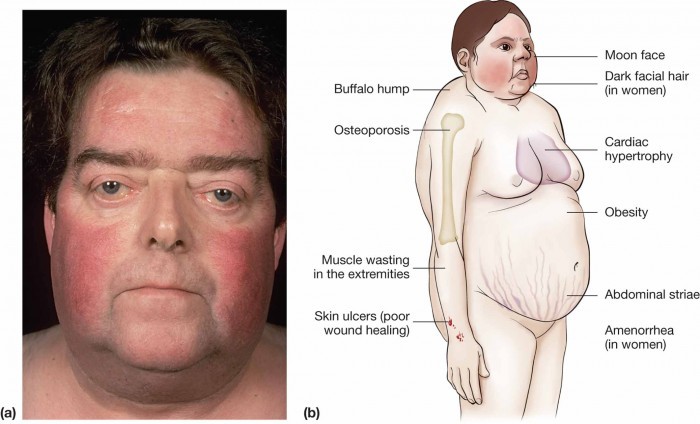Cushing's Syndrome
Definition
Is a collection of symptoms caused by excessive adrenocortical activity
Or due to excessive corticosteroids / ACTH / Hyperplasia of the adrenal cortex
Aetiology
Common : use of corticosteroid medications
Infrequent : excessive corticosteroid production by the adrenal cortex
Tumor of the pituitary gland that prduces ACTH
Primary hyperplasia of the adrenal gland
Ectopic production of ACTH by malignancies: bronchogenic ca.
Incidence
More often found in women of 20 to 40
Clinical Manifestations
Arrest of growth
Obesity - central type - fatty "buffalo hump" in the neck and supraclavicular areas - heavy trunk, relatively thin extremities
Musculoskeletal changes
Glucose intolerance
Skin is thin, fragile and easily traumatazied - ecchymoses (bruises), striae. increased oiliness and acne
Wealness and lassitude
Disturbed sleep
Muscle wasting and osteoporosis due to excessive protein catabolism
Khphosis, backache, compression fracture of the vertebrae
Hypertension and heart failure due to retention of sodium and water
Moon face
Increased susceptibility to infection
Diabetes mellitus
Weight gain
Slow healing ov minor cuts and bruises
Virilization - hirsutism - masculine traits - recession of feminine traits
Menses cease, clitoris enlarges, voice deepens
Libido is lost in men and women
Changes in mood and mental activity, psychosis
Distress and depression
If pituitary tumor is the cause : visual disturbances due to pressure on the optic chisam
Investigations
Serum electrolytes : Na increased, K decreased
Blood glucose : increased
Blood counts : eosinophils reduced
Plasma and Urinary cortisol assessed at various times and the diurnal variations studied
Overnight dexamethasone test
Measurement of plasma ACTH by radioimmunoassay
MRI study to detect tumors of the adrenal and pituitary
Medical Management
Pituitary tumors : Surgical removal by transsphenoidal hypophysectomy
Radiation of the pituitary gland
Primary adrenal hypertrophy : Adrenalectomy
Postoperatively, adrenal insufficiency may occur - to be treated with hydrocortisone for several months until the other adrenal starts coping up with the bodily needs
If due to excessive steroid use : taper down the dose to minimum requirement
Nursing Process
Assessment
History : Patient's activity level and its effect, mental function, skin condition, Physical appearance, moods, responses to questions, level of depression, the gradual changes elicited from the family.
Nursing Diagnosis
Risk for injury
Risk for infections
Self care deficit
Impaired skin integrity
Disturbed body image
Disturbed thought processes related to mood swings, irritability and depression
Collaborative Problems / Potential Complications
Addisonian crisis
Adverse effects of adrenocortical activity
Planning and Goals
Decreased injury
Decreased infecti
Improved ability
Improved skin integrity
Improved body image
Improved mental function
Absence of complications
Nursing Interventions
Decreasing risk of injury : provide protective environment, prevent falls, fractures, assistance in ambulation, prevent bumping into furniture, foods high in protein calcium and vitamin D, food adjusted for electrolyte balance
Decreasing risk for infection : avoid contact with infected persons, remember inflammatory signs are masked by excessive steroids
Preparing the patient for surgery : prepare for adrenalectomy / hypophysectomy, treat peptic ulcer and diabetes mellitus, teach breathing exercises
Encourage rest and activity : encourage moderate activity and rest in quiet environment
Promote skin inegrity : adhesive tape avoided, frequent change of positions
Improve body image : Discuss about the return of normalcy after treatment and reassure
Improve thought process : Explain to the patient about the cause and its treatability, teach to express feelings
Monitoring and Managing Potential Complications :
Addisonian Crisis : monitor for hypotension, pallor, weak pulse, and extreme weakness and treat
Blood Glucose level monitored and treated
Promoting Home and Community based Care
Teach self care : to patient and family. give written instructions, teach dietary modifications, teach monitoring BP, blood glucose, weight
Continuing Care : after surgery care to be continued. visits by home care nurse arranged
Evaluation
Expected patient outcomes :
Decreased injuries
Decreased infections
Increased participation in self-care activities
Attainment of skin integrity
Achievement of improved body image
Improved mental functioning
Absence of complications
* * * * * *




